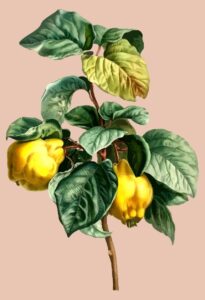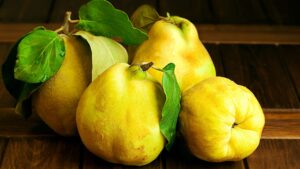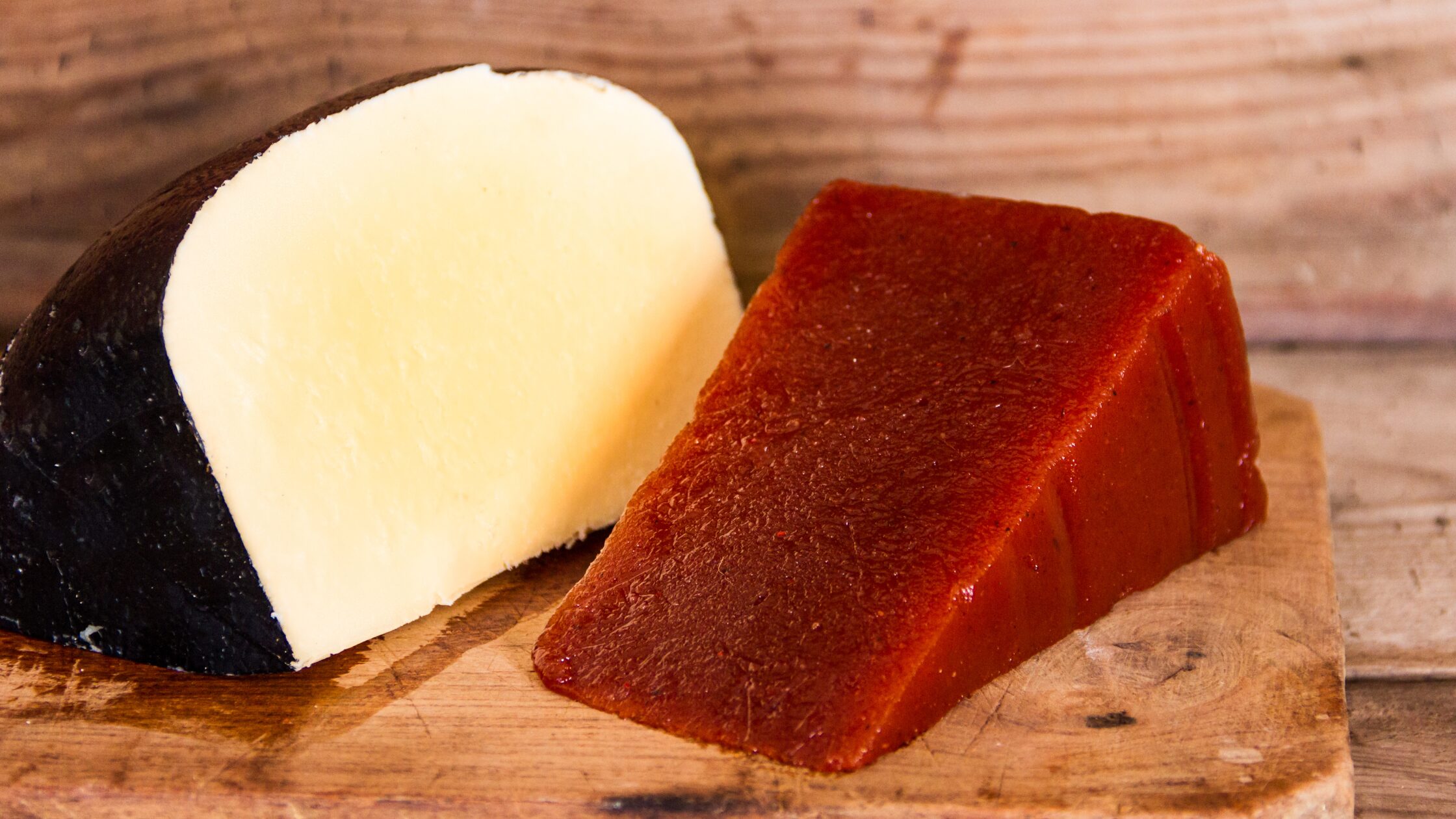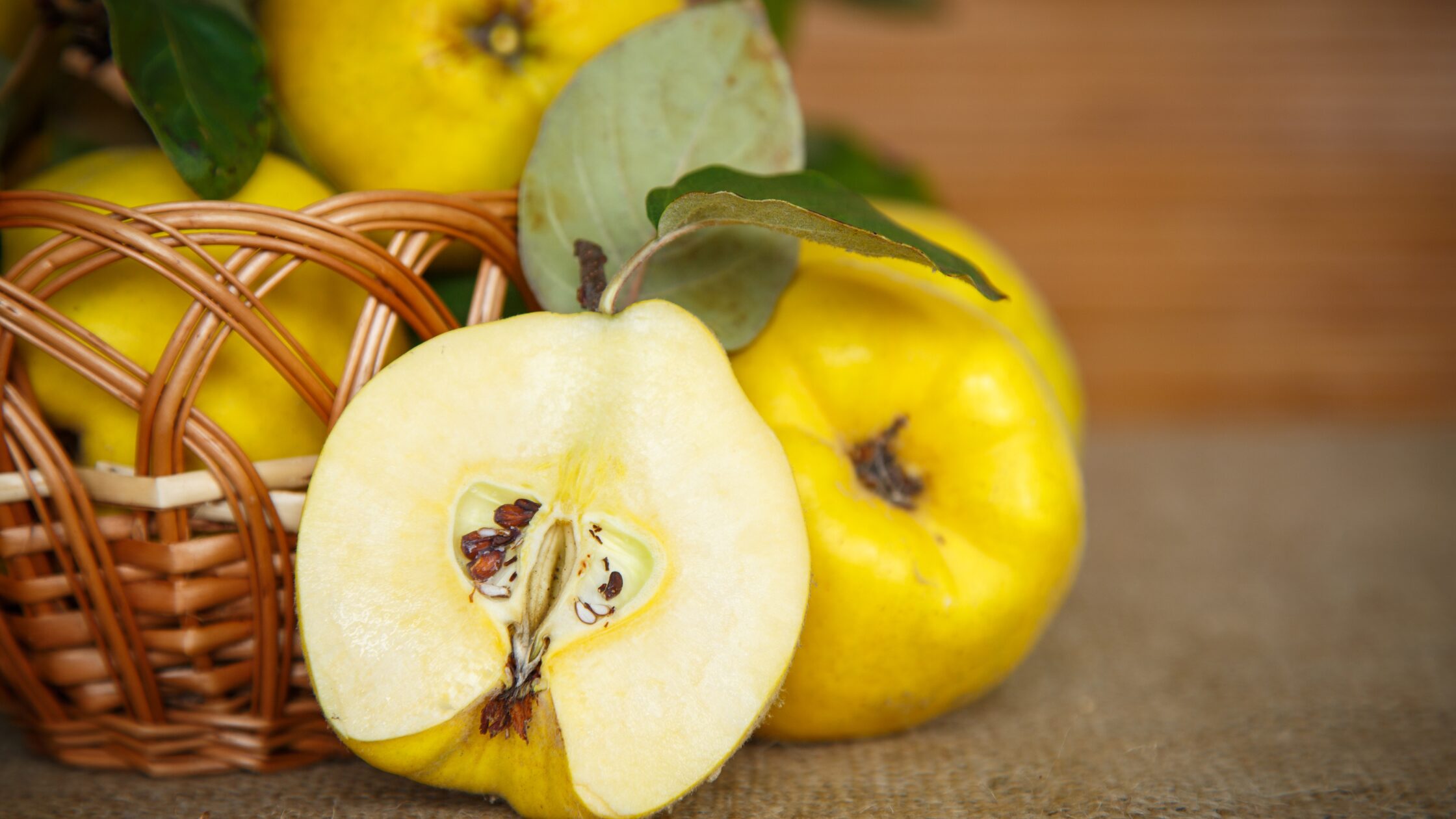.
Once the apples, plums, and pears are harvested, once all the nuts are dried and in bags for storage, and the vegetable garden is cleaned up for winter, we are blessed with one last fruit: the quince. Looking like a knobbly apple but smelling deliciously aromatic, quinces transform from hard and astringent into sweet or savoury preserves and dishes. For decades, quinces were regarded as old-fashioned, but their unique flavour has been rediscovered for preserving and seasonal cooking.
Unlike apples and pears, to which they are related, quinces can’t be eaten raw. Through preservation, however, they transform their colour and release their wonderful fragrance, a mixture of apples, pears and roses. Whether you’ve discovered these golden beauties at a local farmers’ market or are lucky enough to have a quince tree in your garden, I show you five foolproof ways to preserve their unique charm.
From classic jellies to Spanish membrillo (a quince paste) that pairs wonderfully with cheese, these recipes will help you capture the essence of autumn’s golden fruit in jars. Even if you are an absolute beginner and have never preserved fruit before, these step-by-step methods will ensure success in the kitchen.
A Brief History of Quince

Quince is the sole member of the genus Cydonia of the Rosaceae family (source: Wikipedia). As I said before, quinces are related to apples and pears, which are Rosaceae, as well. Originally, quince is native to the region of the Caspian Sea, but it thrives in a variety of climates, even cold ones.
In ancient Greece, quinces were attributed to Aphrodite and often called “golden apples”, which shows how cherished they were even then. But also in Europe, quinces were highly esteemed and for some time even a status symbol for wealth.
Typically, quinces are available from late September through December. While apples and pears store very well and thus can be consumed almost year-round, fresh quinces cannot be stored very long. If we want to extend their enjoyment throughout the entire year, we have to preserve it.
Unique Transformation Process
Raw quinces are hard, astringent and inedible. By cooking and preserving, however, they undergo a remarkable change:
Their colour transforms from a pale yellow to a beautiful rose-pink to red.
Their hard flesh becomes tender and succulent.
Harsh tannins, which are responsible for the astringent effect, develop into a honeylike sweetness.
Their fragrance and flavour intensify.
Culinary Versatility
So, why would we make the effort to preserve quinces? The answer is easy: preserved quinces are more versatile than fresh ones. Quince jelly, for example, brightens your morning toast and pairs very well with roasted meats. Membrillo, a Spanish quince paste, is essential for cheese boards. Preserved quince in syrup can be added to desserts all year round. And have you ever tasted how dried quince can enhance a winter stew!
Apart from adding to your stockpile, home-preserved quince products can also make unique and appreciated gifts for loved ones. Speciality quince preserves may be expensive to buy ready-made, but are affordable to make at home.
Last but not least, quinces are beneficial to our health: they are rich in vitamin C, dietary fibres, as well as antioxidants. Furthermore, they have natural compounds that aid digestion. Best of all, these beneficial properties are retained by our preservation methods.
Before You Begin
Selecting and Preparing Quince

To get the best preserves, you must make sure that you have the best fruit. Quinces are usually ripe between the end of September and the end of October. Only choose firm, ripe quinces without any blemishes. Look for a yellow-gold colour; green quinces are not ripe yet.
If you can’t process the quinces right after harvest, you may store them in a cool and dark place at room temperature, i.e. 13 – 15 °C (55 – 60 °F) for 1 – 2 weeks.
You can also store them in the fridge: wrap them individually in newspaper and put them in the crisper drawer. That way, they’ll last for 2 months.
If you have a very cold basement or a root cellar, you can store quinces in shallow boxes layered with newspaper. At a temperature of 0 – 4 °C (32 – 40 °F) and a humidity of 85 %, they’ll last 3 – 4 months.
Never store quinces in plastic bags as they will retain too much moisture and mould!
Basic preparation steps
There are some basic steps for preparing quinces. First of all, remove the downy fuzz by rubbing it off with a wet cloth. This is an important step as the fuzz causes a bitter taste.
Afterwards, wash the quinces and dry them thoroughly.
Depending on what you want to make, you’ll have to peel the fruits. This is best done with a potato peeler. Then quarter the quinces and remove the core. This may be a bit tricky as the quinces are relatively hard. Be careful with your fingers.
How to preserve quince: preserving methods
There are various methods for preserving quinces, ranging from cooking to juicing and even drying. Let’s break down every method:
Classic Quince Jelly

Classic Quince Jelly
Ingredients
Equipment
Method
- To make quince jelly, we have to make juice first. For that purpose, rub off the downy fuzz, then wash the quinces and cut them into quarters. For making juice, it’s not necessary to peel the quinces or remove the core. On the contrary: as the peels contain a large amount of pectin, it’s advantageous to leave them on.
- There are two methods for making juice from quinces (or apples or pears, for that matter): with a steam juicer or with a normal pot.
- If you use a steam juicer, fill the bottom pot with water to the mark. Put on the juicer pot and insert the fruit basket in which you put all the quince quarters. Close the lid and heat the water. The hot water vapour will gently cook the fruits and release their juice, which gathers in the juice pot. From there, it can be extracted via the attached tube and filled into sterilised glass bottles or jars.
- However, a steam juicer is not the only tool you can use to make juice from quinces. A simple (large) pot with a lid is also ok. In that case, chop the quinces into quarters, put them into the pot and fill it up with water until all the fruits are under the brim. Bring the water to the boil and let it simmer for 45 – 60 minutes. Afterwards, strain the juice through a colander that you layered with a cheesecloth. To squeeze out every last drop of the juice, gently press the quinces. Fill the hot juice into sterilised bottles or jars.
- To make the jelly, measure one litre of the quince juice. Put it into a pot and add 500 g of preserving sugar 2:1 or 500 g of normal sugar and one sachet of pectin.
- Mix it all very well until the sugar has dissolved, and bring this syrup to a boil. Let it boil for 4 minutes and test its consistency by dropping a spoonful of liquid onto a plate. Tilt the plate and let the mixture run. Wipe through the jelly trail with your finger. If it sets, it’s ready to be poured into jam jars. If not, let it boil for another minute and repeat the test.
- When the jelly’s ready, carefully ladle it into jars of 250 ml. Fasten the lid and put the glasses upside down on a dishcloth. After 15 – 20 minutes, put the jars upright again.
- Let the jelly cool down completely, label the jars and store them in a cool, dark place for up to one year.
Membrillo
Shortly put, membrillo is a quince paste, known in France as cotignac and in Germany as Quittenkäse (“quince cheese”). The basic principle is always the same: cook quince with sugar, blend it, then let it set and – optionally – dry it. Easy, isn’t it? Let’s break the process down.

Membrillo
Ingredients
Method
- Rub the fuzz off the quinces and wash them thoroughly.
- Quarter the quinces, peel them and remove the cores and any hard or “grainy” parts. You can use undamaged peels and the cores to make quince vinegar. If you want to know more about that, hop over to this article on apple vinegar. The process is the same, and you’ll get a marvellous homemade vinegar from scraps!
- Weigh the cut quinces before cooking and put them in a pot. Add 1 litre of water and bring it all to a boil. Let it simmer until the quinces are tenderly cooked. This will take 30 – 45 minutes.
- Puree the fruit with a kitchen blender until you get a smooth mass. Add the sugar to the quince puree and let it all cook while constantly stirring. The colour will progressively change from yellow to a brownish-red. Keep stirring well to prevent burning the paste.
- When the dough releases from the sides of the pot, you can ladle it into a square or rectangular form, lined with baking paper.
- Let it cool down completely. When it’s firmly set, you can drop it out of the form.
- If you want to store it, leave it in that shape and cover it with powdered sugar. Afterwards, wrap it in greaseproof paper and store it in the fridge where it will last for at least 3 months. Alternatively, you can freeze membrillo for up to one year.
Notes
Quince in Syrup
Similar to pears, quinces can be canned in syrup. They pair marvellously with rice pudding or can be used as a filling for cakes and pies. And if you haven’t tried quince crumble yet, I sincerely recommend baking one with these quinces in syrup as a base!

Ingredients
Method
- Sterilise jars and lids by rinsing them with boiling water. Let them dry thoroughly.
- Rub the fuzz off the quinces and wash them thoroughly.
- Put some water into a bowl and add the lemon juice or apple vinegar
- Quarter the quinces, peel them and remove the cores and any hard or “grainy” parts. Either leave the quince quarters or chop them into cubes of about 2 – 4 cm (1 inch). Put the quinces into the acidified water so that they won’t turn brown.
- When all the quinces are done, prepare the syrup:
- Put the water and sugar into a pot and stir until the sugar has partly dissolved. Slice the vanilla bean lengthwise and scrape the vanilla out with a knife. Add the vanilla seeds, the sliced pod and the cinnamon stick to the sugar water.
- Bring all to a boil and stir until the sugar has dissolved completely. Let the syrup simmer for 5 minutes.
- Now drain the quince (cubes) and add them to the simmering syrup. Bring it to a boil once again and let it simmer until the quinces are tender (about 45 – 60 minutes). They should have turned a beautiful rose-pink colour by now.
- Pack the quinces into the sterilised jars.
- Remove the cinnamon stick and vanilla bean from the syrup and carefully fill the jars up with syrup, leaving 1 cm (½ inch) of headspace. Immediately seal the jars tightly with the lids.
- Let the jars cool down completely and check the lids for tightness.
- Quinces in syrup can be stored up to one year in a cool and dark place. Once opened, put the jar in the fridge where it may last up to 1 month.
Notes
Serving suggestions
Serve quinces in syrup as a dessert together with whipped cream, vanilla ice cream or yoghurt. It’s also great as a topping to cheesecake, rice pudding or on your morning porridge. Use the syrup to flavour tea, cocktails or sparkling water.
Quince Compote
This quick and easy recipe is one of my favourites! If you just make one dish with quinces, I recommend this recipe for quince compote.

Ingredients
Method
- Sterilise jars and lids by rinsing them with boiling water. Let them dry thoroughly.
- Rub the fuzz off the quinces and wash them thoroughly.
- Put some water into a bowl and add the lemon juice or apple vinegar
- Quarter the quinces, peel them and remove the cores and any hard or “grainy” parts. Chop the quarters into cubes of about 2 – 4 cm (1 inch). Put the quince cubes into the acidified water so that they won’t turn brown.
- Drain the quinces and put them into a pot. Add the water, sugar and spices and bring all to a boil. Let the quinces simmer until they’re soft (20 – 30 minutes).
- You can eat the compote just like that, or you can put it still hot into the sterilised jars with ½ inch (1 cm) headspace. Secure the lids tightly. To prolong its shelf-life, can the compote for 30 minutes at 80 °C in a water-bath canner.
Notes
Serving suggestions
Serve quince compote with your morning porridge or granola. It also makes a great topping for waffles and French toast. Or just stir it into yoghurt to make a quick and yummy dessert.Dried Quince
Who would have thought that you could dry quinces? For a long time, I believed that quinces had to be cooked to become edible, but obviously, drying them is also a great method for preserving them. Dried quince is a delicious snack to go, but can also be used in stews, cakes or even as tea!

Ingredients
Method
- Rub the fuzz off the quinces and wash them thoroughly.
- Put some water into a bowl and add the lemon juice or apple vinegar
- Peel the quinces if you like, but it’s not essential. Quarter them and remove the cores and any hard or “grainy” parts.
- Cut the quinces into slices of about ¼ inch (6mm) and put them into the lemon water to prevent browning.
- Drain the quince slices and dab them dry.
- You can either dry the quinces in the oven or a dehydrator.
- Clean the dehydrator trays and arrange the quince slices so that they don’t overlap. Start the dehydrator at 60 °C (135 °F) and dry the slices until they’re leathery.
- Line parchment paper on trays or racks and arrange the quince slices so that they don’t overlap.
- Set your oven to 60 °C / 140 °F (fan oven) and put the racks or trays with the quinces in. Prop the door slightly open by sticking a wooden spoon into the opening. That way, the condensation water can evaporate.
- Dry the quinces for 6 – 12 hours.
- Note: it’s impossible to give you an exact drying time as it depends on many factors like air humidity, room temperature, thickness of the slices and the overall moisture content of the fruit.
- First, properly dried quince should be leathery and pliable, not sticky or tacky to the touch. When you cut or squeeze them, there mustn’t be any moisture.
- The most important point is to let the dried quinces cool completely before storing. Once they are cool, put them into airtight containers or vacuum-sealed bags. Stored in a cool and dark place, they will last for 6 - 12 months if properly dried.
Notes
How to use dried quince
The most common (and fastest) use is to snack on dried quinces directly as they are. You can also add them to your morning granola or mix them with nuts for a healthy snack mix. You can, however, also use dried quince in a more versatile way in sweet and savoury dishes: - Soak them in hot water, tea or wine, for example, until they are soft again (approx 15 – 30 minutes). Then use the soaking liquid in recipes as it contains flavour and nutrients. - Add dried quinces to food like Middle Eastern stews (especially khoresh), Moroccan tagines or Turkish compotes. It’s also a great component of European meat dishes, pairs well with savoury dishes like rice pilaf or can be part of stuffing mixtures. - Chop your dried quince and add it to your oatmeal or porridge. It adds a delicious flavour (and some nutrients) to yoghurt and breakfast cereals. Also, dried quince can be baked very well into muffins, scones or bread. Use it in fruit cakes or spiced holiday desserts as well as in ice cream or frozen yoghurt. - Use dried quince for beverages. For example, steep it in hot water for a fruity tea. You may also add it to mulled wine or cider to add a fruity flavour.Quinces are Great!
The versatility of quinces makes them a rewarding fruit to preserve, whether you’re drawn to the ruby-red glow of poached quinces, the sweet intensity of membrillo, or the delicate flavour of quince jelly. While these ancient fruits require more time and patience than modern quick-preserving methods, the results are truly worth the effort. The transformation of hard, astringent quinces into tender, aromatic preserves is a wonderful tradition that connects us to generations of home preservers before us.
Whether you’re an experienced preserver or trying quince for the first time, remember that the key to success lies in selecting ripe, fragrant fruit and taking the time to prepare it properly. Your reward will be a pantry stocked with preserved quinces to enjoy throughout the year, adding their unique flavour to cheese boards, desserts, or simply spread on fresh bread.
If you are lucky enough to have a quince tree in your yard or know someone with a quince tree who is eager to share their harvest with you, don’t hesitate to try preserving them! Not only will you be participating in an age-old culinary tradition, but you’ll also be creating something truly special that can’t be found on supermarket shelves.
Do you want more autumn fruit recipes? Try out these:


0 Comments